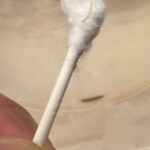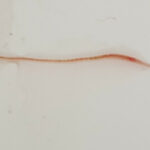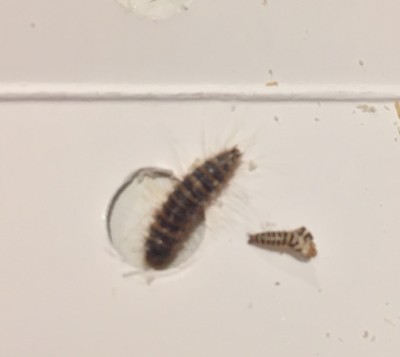
“My cat dropped this on my chest”, writes Taylor in his submission regarding the pink, worm-like creature with a white head and pronged rear. “What is it? A worm? A centipede? I included a picture of how it looks and a video to show how it moves. I appreciate your help!” Now, while being shaped like a worm and having clear-cut segmentation like a centipede, we do not believe this creature is either a worm or a centipede. We actually think it is a larva, specifically a beetle larva. We are not certain exactly which species of beetle this belongs to. The pink coloration reminds us of the scarlet malachite beetle, but the white head throws us off that course. In fact, the inchworm-like movements of the creature (as seen in the video linked below) has us doubting if it is a beetle larva at all.
If it were not for the prong-like appendage on the critter’s rear, we would have said this was likely a caterpillar, but this body part is so characteristic of beetle larvae that this has to be one. Since we do not know what species this is specifically, we cannot promise that it is not harmful, though we will say that — generally speaking — beetle larvae do not pose any significant threat to humans. If they have a forked rear like this one, it is possible that they can pinch you. On top of that, certain insect larvae are potential hosts for parasites, pathogens, or diseases, but typically those can only be contracted by ingesting the infected larva. It is good that Taylor’s cat brought the larva to him, rather than eat it whole. Of course, if Taylor is concerned that his cat may have found more of these and eaten them, we suggest he take his cat to a vet. We cannot confirm or deny if he should be concerned by this, as only a medical professional will be able to give those kinds of affirmations.
If Taylor’s cat is an outdoor cat, it is generally good practice to take them to check-ups at the vet, since there are so many potentially dangerous things they can eat out in the wild. If the cat is an indoor cat, then the larva was found inside his home. It is possible that it wandered in from outside, though it is also possible that it was born inside the home: an adult beetle having laid its eggs inside. We recommend that Taylor search his home for any more larvae, and that he move any that he finds outside. He might want to avoid touching them in case they do pinch you, and scoop them onto a dustpan to move them. If he finds any areas with a high concentration of larvae, we advise vacuuming that area, as there could be more unhatched eggs. In fact, if he finds more larvae at all, it is probably a good idea to vacuum the entire home just in case.
To conclude, we think Taylor’s cat found a beetle larva, though we are not sure exactly what species it is. In any case, it should not pose any real danger to Taylor or his cat, though it might be worth taking the cat to the vet in case it has ingested any of these. If any of our other readers have any ideas about what beetle species this larva might belong to, they are free to share them in the comments section below. We hope this helps, and we wish Taylor and his cat the very best.
All About Worms is always free, always reader-supported. Your tips via CashApp, Venmo, or Paypal are appreciated! Receipts will come from ISIPP Publishing.
You might also find these guys interesting!

















